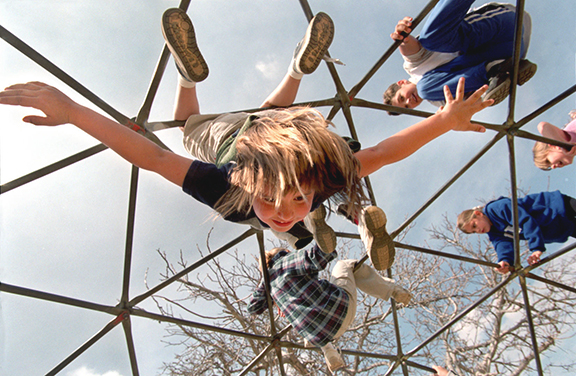Exercise Can Help Kids Do Better In School
Attention parents: If you’d like to see your kids do better in school, have them close their books, set down their pencils and go outside to play.

If you’d like to see your kids do better in school, have them close their books, set down their pencils and go outside to play. Study after study proves that students need adequate amounts of physical activity throughout the school day.
And so it goes. Students in every grade level at schools across the country are struggling in class. It’s not because they’re underachievers or they’re not smart. It’s not even because they don’t care. It’s because they aren’t getting enough physical activity! Study after study proves that students need adequate amounts of physical activity throughout the school day.
So what do I feel is the missing link between reducing obesity and increasing America’s ability to compete in a tough global economy? Physical education, physical activity and just plain old exercise of any kind in our children’s day.
Not surprisingly, exercise whether it comes in the form of a karate lesson, soccer tournament, family hike or bike ride will help them perform better academically. Equally important, it will also help prevent obesity and other health related disorders like diabetes and heart disease.
According to research, physical activity before, during and after school promotes scholastic performance in children and youth. Though all of these activities take kids out of the classroom or away from their homework, they are still a good investment in academic achievement. Even a single break for moderate-intensity exercise can boost brain function, cognition and scholastic performance.
The benefits also extend to the psychological and social realm. Exercise will improve their behavior, help them make friends, and allow them to feel more confident around their peers as well as coaches and other adults.
If you’re worried that your son or daughter will lose precious minutes doing their homework or studying for an exam, you can relax. Time taken away from academic lessons in favor of physical activity has been shown to not come at the cost of scholastic performance.

Exercise will improve children’s behavior, help them make friends, and allow them to feel more confident around their peers as well as coaches and other adults.
Unfortunately, many schools cut physical education and funding with the belief that more rigid classroom time would somehow stimulate students to learn more. It’s an incorrect belief, and there’s scientific evidence to prove it.
Here’s how exercise may affect your child’s ability to function in the classroom:
Increased oxygen flow to the brain
Increased brain neurotransmitters
Increased brain-derived neurotrophins that support neuronal differentiation and survival in the developing brain. Neurotrophins assure the survival of neurons in areas responsible for learning, memory and higher thinking.
Physical activity has benefits beyond improved grades. Getting outside and being active can also be directly linked to absenteeism, drop-out rates and social connectedness. According to research, drop-out rates were lower for youth who consistently participated in interscholastic sports.
So what can school districts do to incorporate more activity and movement into the school day? First, administrators must let go of the dated idea that physical education must take a backseat.
There is currently no evidence indicating that this strategy is, in fact, effective in increasing standardized test scores. In fact, a growing body of evidence shows that increased time for physical education and other school-based physical activity programs is associated with a positive impact on academic outcomes.
An adequate physical education curriculum can help children achieve these numbers, in turn creating healthy bodies and eager-to-learn minds. Adequate opportunity for physical activity doesn’t stop there; it also sets children up for a healthy adulthood, perpetuating a cycle of well-being for generations to come.
This is a very consistent finding that physically fit kids do better in school. A recent report from the Institute of Medicine asserts that children who are more active show greater attention, have faster cognitive processing speed, and perform better on standardized academic tests than children who are less active.
A strong body of research supports the link between physical fitness and test scores. In one study, for example, nearly 2,000 California schoolchildren who were outside a “healthy fitness zone” (a 12-year-old who took longer than 12 minutes to run a mile would be outside that zone) scored lower on state standardized tests than those who were more fit.

Physical activity should have a place in the curriculum of every school that’s serious about teaching its kids.
The more important question is: Does adding opportunities for physical activity during the school day boosts kids’ capacity to learn? The research and evidence is beginning to suggest that the answer is yes.
One recent study conducted in Georgia invited 111 inactive, overweight kids, age 7 to 11, to participate in an after-school exercise program, during which they were active for at least 20 minutes. Another 60 kids, also overweight, were wait-listed and served as controls. After 13 weeks, the kids in the exercise program performed better than the controls on tests of mental tasks such as planning, organizing and strategizing, as well as on standardized math tests.
In Kansas, an intervention designed to combat obesity also found a link between physical activity and learning. In the study, teachers at 14 elementary schools were trained to teach lessons using movement; for example, students might hop or run to letters on the floor to spell words or might solve 2+2=4 by moving their bodies rather than blocks. Ten other schools served as controls; their teachers received no training.
The added activity had positive effects on body weight. In the schools where activity was added, 21.8 percent of children who were at risk for obesity moved into the normal range for body mass index (a measure of weight that takes height into account); in the control schools, 16.8 percent of at-risk kids moved to normal.
To the researcher’s surprise, scores on a thirty minute standardized test of reading, writing and math were higher in the schools that used active lessons than in the schools that didn’t. The evidence is growing that physical activity is even more beneficial than previously thought.
In Conclusion
There is little dispute that physical activity is good for kids. It offers opportunities to socialize and learn new skills. It has a positive impact on cognitive skills, attitudes and academic behavior, all of which are important components of improved academic performance. It also helps prevent obesity and other health related disorders.
The evidence is clear. Physical activity should have a place in the curriculum of every school that’s serious about teaching its kids. How this translates into children’s lives, where video games and other sedentary activities are a constant allure, is a challenge parents and schools must face together.










